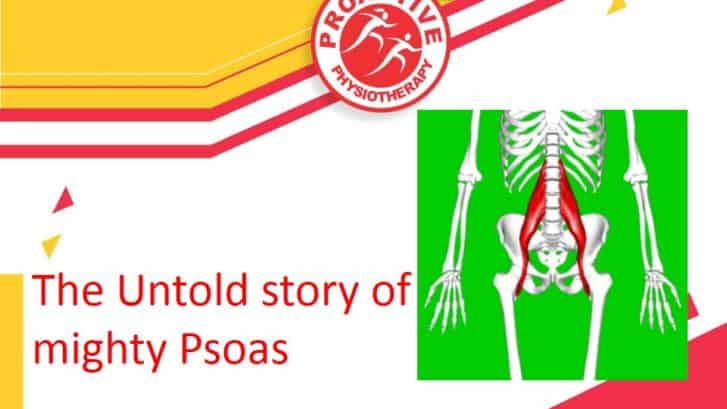The untold story of mighty psoas Part 2
Kindly read previous blog to understand second one ,
The mighty psoas untold story
The hip joint is a triaxial joint that allows motion in all three cardinal planes. Therefore we can examine the effect of the psoas major in each of the three cardinal planes. Further, we need to consider the open-chain motions of the thigh relative to the pelvis at the hip joint and vice versa.
Sagittal Plane : 
In the sagittal plane, there is little or no controversy over the potential action of the psoas major at the hip joint. It clearly crosses the hip joint anteriorly, passing anterior to the mediolateral axis of motion. therefore it flexes the hip joint. If we are in an open-chain position, the thigh flexes at the hip joint. If we are in a closed chain position the pelvis anteriorly tilts at the hip joint.
Sagittal Plane: From expert point of view:
the psoas major is a flexor of the hip joint. In fact, most sources state that hip flexion is its primary function. According to Stuart McGill “The role of the psoas is purely as a hip flexor.” And many sources go on to describe the psoas major’s hip flexion role rather effusively. Janet Travell and David Simons described the psoas major as a “major muscle of hip flexion” ; and its hip flexion role has been described by others as “strong” , “powerful” , or “dominant” .
Carol Oatis specifically points out that the psoas major is a “strong hip flexor” because it has a large physiological cross sectional area . Sometimes authors discuss the psoas major along with the iliacus as the iliopsoas. In these cases, it can be difficult to determine what to ascribe to the psoas major versus the iliacus, but the iliopsoas as a whole is often stated to be the prime mover (in other words, the most powerful mover) of hip joint flexion .
One study states that the psoas major’s hip flexion is relatively weak at the beginning and end ranges of motion, and that it is strongest between 45 and 60 degrees of flexion . In fact, many authors believe that the primary role of the psoas major is not to actually move the bones at the hip joint by concentrically contracting, but rather to stabilize the bones of the hip joint by isometrically contracting .
A Muscle’s Contraction:
Determining what joint action a muscle can create is a factor of the line of pull of the muscle relative to the joint’s axis of motion. However, other factors must be looked at to determine the strength that the muscle will have when creating this motion.
It would make sense that these other hip flexor muscles with greater moment arms would more efficiently pull the hip joint into flexion.
Evan Osar believes that the major role of the psoas major at the hip joint is to stabilize and center the head of the femur in the acetabulum as other hip flexors contract .He uses the term “centration” to describe this idea.
Gibbons also believes that the primary role of the psoas major at the hip joint is stability. He points out that the fiber architecture of the psoas major is not fusiform; rather it is unipennate muscles. .Pennate muscles are designed to produce greater force over a shorter distance, whereas non pennate muscles are designed to produce a greater range of motion.
What to conclude from this discussion?
There is no doubt that the psoas major’s line of pull is anterior to the hip joint and that its contraction creates a force of flexion at the hip joint. The only question seems to be whether this hip flexion force is more important for motion or for stabilization. These concepts, however, do not need to be mutually exclusive as a muscle can have a stabilization role as well as a role in motion.
Generally, it is true that deeper muscles at a joint tend to function more for stabilization than for motion, and looking at the psoas major’s location does show it to be a deep muscle.
References:
- Kapandji, I. A. (1974). The physiology of joints: Volume three: The trunk and the vertebral column. Edinburgh: Churchill Livingstone of Elsevier.
- Kendall, F. P., McCreary, E. K. & Provance, P. G. (1993). Muscles: Testing and function (4th). Baltimore: Williams & Wilkins.
- Levangie, P. K. & Norkin, C. C. (2011). Joint structure and function: A comprehensive analysis (5th). Philadelphia: F. A. Davis.
- Lewit, K. (2010). Manipulative therapy: Musculoskeletal medicine. Edinburgh: Churchill Livingstone or Elsevier.
- Gibbons, S. (2007). Clinical anatomy and function of psoas major and deep sacral gluteus maximus. Published in Movement, stability & lumbopelvic pain: Integration of research and therapy (2 ed.). (Edited by Vleeming, A., Mooney, V., & Stoeckart, R.) Edinburgh: Churchill Livingstone of Elsevier.
- Neumann, D. A. (2010). Kinesiology of the musculoskeletal system: Foundations for rehabilitation (2nd). St. Louis: Mosby of Elsevier.
- Oatis, C. A. (2004). Kinesiology: The mechanics & pathomechanics of human movement. Baltimore: Williams & Wilkins.
- Osar, E. (2012). Corrective exercise solutions: To common hip and shoulder dysfunction. Chichester: Lotus Publishing.
inage courtesy : kinesiology-the-skeletal-system-and-muscle-function-3rd-edition




Leave a Reply
Want to join the discussion?Feel free to contribute!